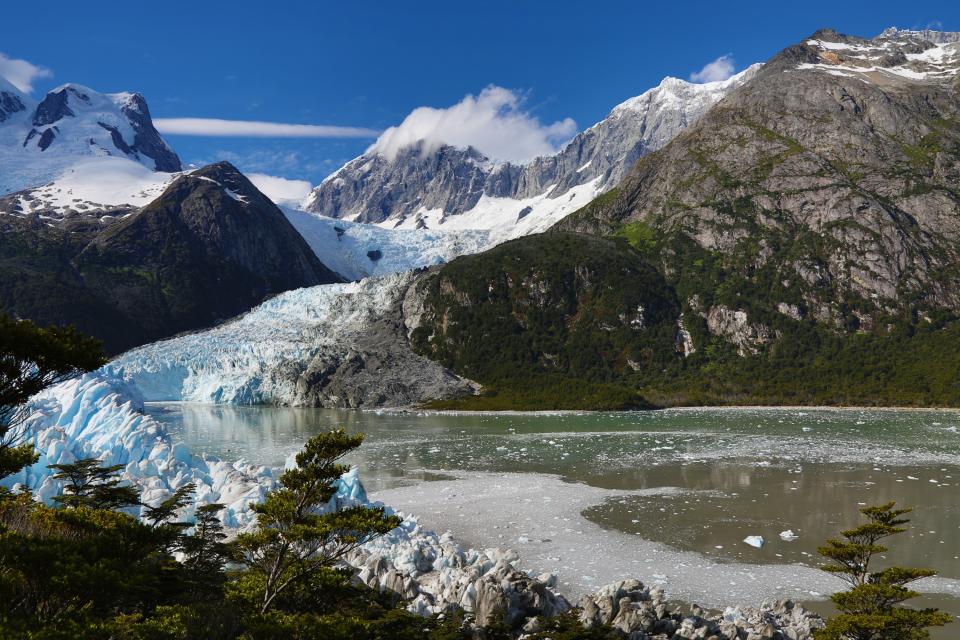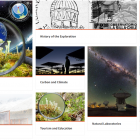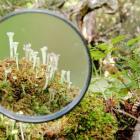Introduction: Making the Invisible Visible in the Natural Laboratories of Chile’s Extreme Zones
Chile’s Natural Laboratories: Eyes of the World to Explore the Macrocosmos and Microcosmos
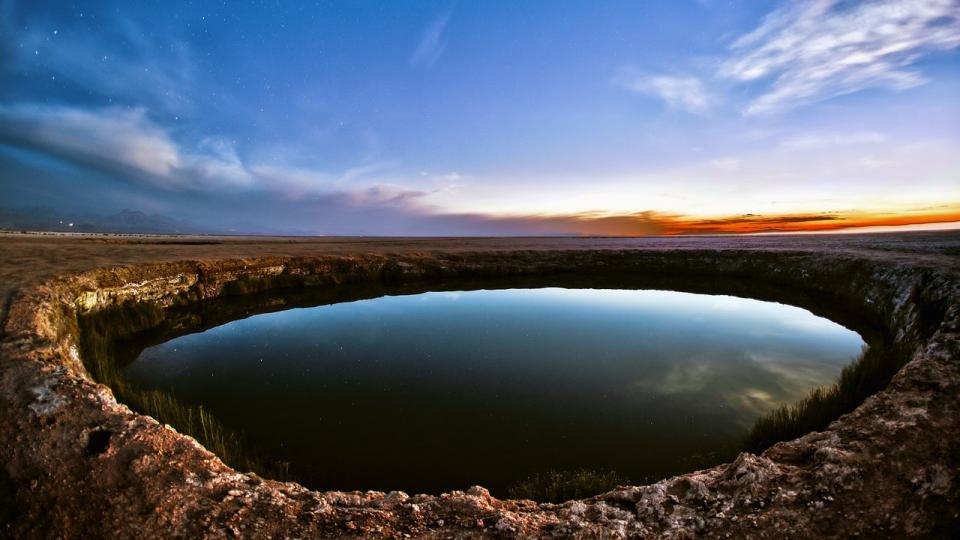
Figure 1. This picture was taken at the northern tip of the Salar de Atacama—the largest salt flat in Chile. The flat is close to the town of San Pedro de Atacama, a town in northern Chile very popular among Chilean tourists and international visitors. The salt flat is home to two similar freshwater lagoons that lie very close together: the Ojos del Salar, which translates to “Eyes of the Salt Pan.” Photograph by Adhemar Duro, n.d.
Figure 1. This picture was taken at the northern tip of the Salar de Atacama—the largest salt flat in Chile. The flat is close to the town of San Pedro de Atacama, a town in northern Chile very popular among Chilean tourists and international visitors. The salt flat is home to two similar freshwater lagoons that lie very close together: the Ojos del Salar, which translates to “Eyes of the Salt Pan.” Photograph by Adhemar Duro, n.d.
Photo by Adhemar Duro. Courtesy of ESO.
Click here to view source.
 This work is licensed under a Creative Commons Attribution 4.0 International License.
This work is licensed under a Creative Commons Attribution 4.0 International License.
Being a unique location worldwide is the first attribute that defines a natural laboratory. In order to establish itself as such, in addition to contributions to knowledge and innovation, two particularities are required: the definition and implementation of a public policy focused on a problem or opportunity of national and/or global relevance and the development of a critical mass in some discipline that has achieved international impact. In the extreme north of Chile, the Atacama Desert has been established as a natural laboratory for astronomical observations and in the extreme south of the country, the Cape Horn Biosphere Reserve (CHBR) offers an ideal site for research on the impact of climate change (and global socio-environmental change more widely) on biological and cultural diversity (Rozzi et al. 2016). In this section we first introduce the biophysical attributes, and then the conceptual and institutional attributes, of these laboratories, special sites that emerge from Chile as “eyes of the world” to investigate the macrocosmos and microcosmos.
The original virtual exhibition includes the option to switch between the microcosm and macrocosm within the individual chapters.
Here we present the subchapters one after the other.
Unique Geographical Locations of Chile’s Natural Laboratories
Cape Horn Biosphere Reserve
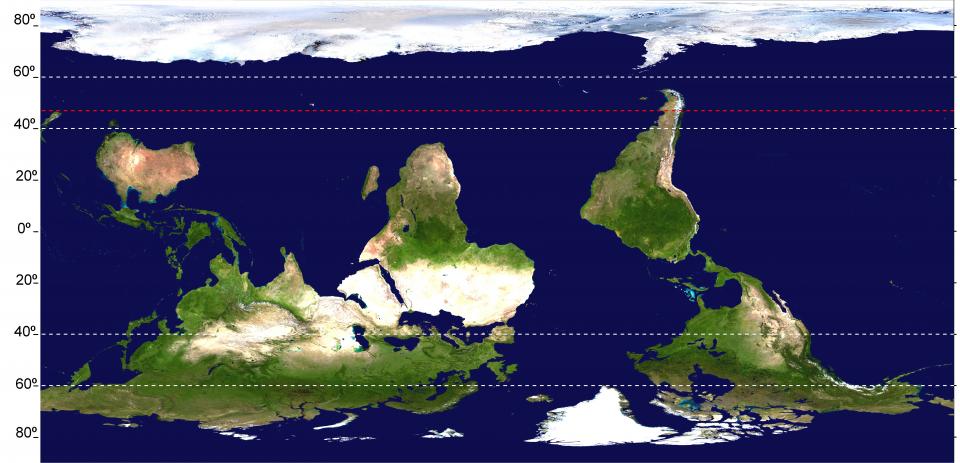
Figure 3. World map with south on top, illustrating how Cape Horn emerges as a summit of the Americas. The red dashed line marks latitude 47° south, which corresponds to the southernmost forests of New Zealand. The forests of Cape Horn are located at 56° south, almost ten degrees latitude further south than those of New Zealand and represent the southernmost forests in the world. White dashed lines demarcate latitudinal ranges between 40° and 60°, showing the stark contrast between the Southern (predominantly oceanic) and Northern (predominantly continental) Hemispheres. Figure modified from Rozzi (2018).
Figure 3. World map with south on top, illustrating how Cape Horn emerges as a summit of the Americas. The red dashed line marks latitude 47° south, which corresponds to the southernmost forests of New Zealand. The forests of Cape Horn are located at 56° south, almost ten degrees latitude further south than those of New Zealand and represent the southernmost forests in the world. White dashed lines demarcate latitudinal ranges between 40° and 60°, showing the stark contrast between the Southern (predominantly oceanic) and Northern (predominantly continental) Hemispheres. Figure modified from Rozzi (2018).
© Fundación Omora. Used by permission.
The copyright holder reserves, or holds for their own use, all the rights provided by copyright law, such as distribution, performance, and creation of derivative works.
At the extreme south of Chile, Cape Horn’s geographical location at the extreme latitude of the American continent is ideal for investigating responses of biodiversity to climate change because the landform resembles a “summit” with a small terrestrial area particularly sensitive to incremental temperature changes. Southwestern South America and other ecosystems at high latitudes and altitudes are experiencing some of the fastest rates of warming on the planet. However, monitoring and experimental studies of the ecological responses of subpolar and alpine terrestrial biota to climate change have concentrated on subarctic or mountain areas of the Northern hemisphere. In the Northern hemisphere, it has been demonstrated that climate change is shifting the distribution and composition of species, key ecological interactions, and ecosystem functioning. At Cape Horn, researchers investigate if similar shifts are taking place in southwestern South America using experimental approaches, modeling and long-term monitoring. At a global scale, this work enables better understanding of the consequences of climate change through analysis of climate systems and the responses of biodiversity and ecosystems to warming trends at high latitudes in general. In this respect, the Cape Horn Biosphere Reserve (CHBR) has at least ten unique attributes:
- The CHBR has no geographic replica in the Southern hemisphere. Just as Mount Everest emerges as the highest summit in the world, Cape Horn emerges as the southernmost summit of the American continent (Figure 3). Cape Horn is also home to the highest latitude forests in the Southern hemisphere. Due to their altitudinal or latitudinal position, both summits, Everest and Cape Horn, are subject to unique and extreme climatic conditions, an attribute that becomes critically relevant when we face global climate change. This statement begins the document presented to UNESCO to create the CHBR in 2005.
- Unique biodiversity and high levels of endemism. The lush forests and moorlands of the CHBR and subantarctic Magellanic ecoregion are home to more than 5 percent of the bryophyte species (mosses and liverworts) described worldwide, which are found in less than 0.01 percent of the planet’s land surface. In addition, about 60 percent of the bryophyte species are endemic to the temperate forest biome.
- One of the world’s last wilderness areas. In the twenty-first century, Cape Horn embedded in the subantarctic Magellanic ecoregion has been identified as one of the 24 wilderness areas remaining on the planet, because it (i) conserves more than 70 percent of its original vegetation cover, (ii) encompasses an area of more than ten thousand square kilometers that lacks terrestrial connectivity, industrial, and urban development, and (iii) has one of the lowest human population densities in temperate latitudes (0.14 inhabitants per square kilometer).
- Oceanic climate. In contrast to the continental climate (freezing winters and hot summers) that characterizes boreal forests, the climate of the subantarctic forests of Cape Horn is moderated by a strong oceanic influence that determines its mild winters and cool summers. The isothermal climatic conditions recorded in the subantarctic forests could be a determinant factor for higher longevity and different migration patterns of birds as compared to the subpolar forests in the Northern hemisphere.
- Cape Horn: “a geographic funnel” for migratory forest bird species. In contrast to the Northern hemisphere boreal forests, which offer a vast expanse of habitat to returning breeding migratory birds, Cape Horn is characterized by a narrow tip where migratory forest birds converge. This geographical attribute has methodological advantages for the study of migration, and provides a unique natural laboratory for interhemispheric comparative studies of the avifaunas of subpolar forests. Due to their migratory behavior, birds of the Northern hemisphere subpolar forests are studied today as a sensitive biological indicator of global climate change. Birds of subpolar ecosystems in Cape Horn now provide a valuable indicator group to monitor global climate change under environmental conditions that are biologially, geographically, and climatically different from the subpolar ecosystems in the Northern hemisphere.
- The largest area of temperate and subpolar forests in the Southern hemisphere. Cape Horn in the subantarctic Magellanic ecoregion is part of the South American temperate forest biome, which extends over 26 degrees of latitude (30º–56º south) and covers an area of about 15.6 million hectares in southwestern South America. This represents the largest expanse of temperate forests remaining in the Southern hemisphere, more than twice as much as the 5.9 million hectares of the temperate forests of New Zealand (40º–47º south) and Tasmania (41º–44º south) combined. Hence, southwestern South America represents a unique natural laboratory.
- The world’s cleanest rainwater and streams. Because southwestern South America is positioned outside of air streams carrying industrial pollutants and receives rainstorms that originated over the southern Pacific Ocean, the austral forests and associated ecosystems are to a large extent free of atmospheric pollution. Precipitation chemistry in this region reveals one of the lowest concentrations of nitrates ever recorded. Therefore, the soils and streams in Cape Horn provide a unique baseline to study the linkages between atmosphere and biosphere under conditions similar to those that prevailed prior to the industrial revolution.
- Highly sensitive insects and ecosystems to climate change. The high latitude regions of the Antarctic Peninsula and the Magellanic subantarctic have been amongst the most rapidly warming areas in the world, showing significant glacier retreat and reduction of snow and ice cover in terrestrial and freshwater ecosystems. These regions are inhabited by organisms, such as insects, that are highly sensitive to environmental change and thus are considered model to study the effects of climate change on ecosystems and biota.
- Patagonian ice fields. Southwestern South America contains vast areas of continental ice: 4,200 square kilometers in the Northern Patagonian Icefield, 13,000 square kilometers in the Southern Patagonian Icefield, and 2,300 square kilometers in the extensive glacier systems of the Cordillera Darwin in Tierra del Fuego and the neighboring archipelagos in the CHBR. Together, these glaciers are (a) the largest ice masses in the Southern hemisphere, aside from those in Antarctica; (b) immense reservoirs of fresh water; (c) unique depositories of records of past climate changes at high southern latitudes; and (d) more sensitive to global climate change than the Alaskan glaciers.
- The largest area of parks and biosphere reserves in the temperate Southern hemisphere. Providing opportunities for conservation and scientific research within the austral temperate forest biome are several large protected areas in the Chilean subantarctic Magellanic ecoregion. The CHBR and the Diego Ramírez Islands – Drake Passage Marine Park protect an area of 25 million hectares.
Today the Cape Horn International Center (CHIC) contributes to three globally relevant innovations to advance understanding of the complex challenges of global socio-environmental change, and to reorient processes that drive biological and cultural diversity losses and ecosystem degradation towards processes of biocultural conservation that promote social, economic, and environmental sustainability. First, CHIC provides a new Scientific and Technological Center of Excellence in a remote area that hosts the world’s southernmost forest ecosystems at 56° south (i.e., nine degrees latitude south of the southernmost island of New Zealand). Consequently, Cape Horn has no geographic equivalent in the Southern hemisphere. Hence, CHIC will contribute to resolving a geographic gap in global monitoring and long-term ecological research about the responses of subantarctic (terrestrial, freshwater, and coastal-marine) biodiversity and ecosystems to climate change. Second, CHIC is implementing a novel biocultural approach that includes multiple forms of ecological knowledge and values, and integrates natural sciences, social sciences, education, and environmental ethics. With this approach, CHIC is investigating biocultural homogenization, a new indirect driver of global socio-environmental change that entails interwoven losses of biological and cultural diversity at local, regional, and global scales. In this way, CHIC will contribute to resolving a conceptual gap by addressing a new indirect driver of global change that combines biotic and cultural factors. Third, CHIC is innovating by integrating this biocultural framework into transdisciplinary research for the design and evaluation of (i) socio-environmental policy, (ii) sustainable economic activities, (iii) educational methodologies linked to biocultural heritage, and (iv) management plans for marine and terrestrial protected areas. This approach is consistent with the UN Sustainable Development Goals and UNESCO’s Man and Biosphere Program, which provides an international platform to facilitate its applicability in other regions of the world.
Atacama Desert
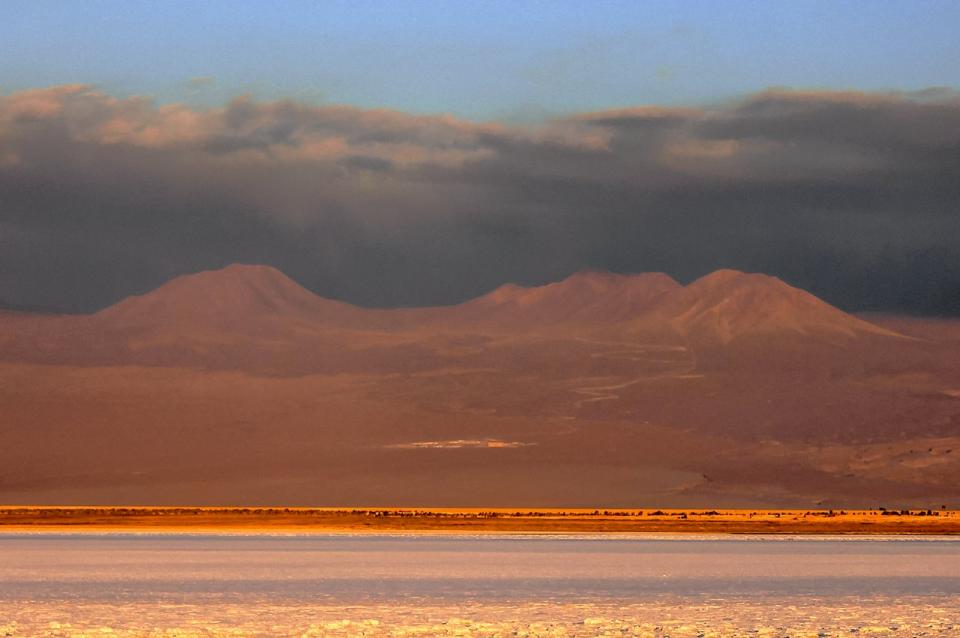
Figure 2. The breathtaking Chajnantor Plateau in the Atacama Desert, at an altitude of five thousand meters in the Chilean Andes, houses the Atacama Large Millimetre/submillimeter Array (ALMA). Its harsh environment of dry air, isolation, and nearly non-existent cloud cover makes it one of the best places in the world for astronomical observations. Photograph by G. Rojas, n.d.
Figure 2. The breathtaking Chajnantor Plateau in the Atacama Desert, at an altitude of five thousand meters in the Chilean Andes, houses the Atacama Large Millimetre/submillimeter Array (ALMA). Its harsh environment of dry air, isolation, and nearly non-existent cloud cover makes it one of the best places in the world for astronomical observations. Photograph by G. Rojas, n.d.
Courtesy of the G. Rojas/ESO.
Click here to view source.
 This work is licensed under a Creative Commons Attribution 4.0 International License.
This work is licensed under a Creative Commons Attribution 4.0 International License.
The extreme north of Chile hosts the Atacama Desert, the world’s driest hot desert that covers an area of 105,000 square kilometers. Due to its geological, geomorphological, and climatic characteristics, this desert has exceptional attributes for astronomic observations. An average of 330 clear nights a year, a dry climate, and the Andean Cordillera with numerous mountains of over 3,000 meters of altitude make the Atacama Desert the best place on the planet to build optical and radio telescopes. One of the major endeavors has been undertaken by the European Southern Observatory (ESO), which with its telescopes has made breakthroughs in astronomy, among them:
- Stars orbiting the Milky Way black hole: ESO’s flagship telescopes revealed empirically for the first time the effects predicted by Einstein’s general relativity on the motion of a star passing through the extreme gravitational field near the supermassive black hole in the center of the Milky Way.
- Accelerating universe: Based on observations of exploding stars, including those from ESO’s telescopes at La Silla and Paranal, two independent research teams have shown that the expansion of the universe is accelerating.
- Planet found in habitable zone around nearest star, Proxima Centauri: ESO’s astronomic platform in the Atacama Desert has shown this planet to be a rocky world a little more massive than the Earth. It is the closest exoplanet to us—and it may also be the closest possible abode for life outside the Solar System.
- Astronomers capture first image of a black hole: ESO, ALMA (the Atacama Large Millimeter/submillimeter Array), and APEX (the Atacama Pathfinder Experiment) contributed to paradigm-shifting observations based on the first direct visual evidence of a supermassive black hole and its shadow. The image reveals a huge black hole at the centre of Messier 87, a massive galaxy in the nearby Virgo galaxy cluster.
- Revolutionary ALMA image reveals planetary genesis: In 2014, ALMA revealed remarkable details of a solar system that is forming, and showed how forming planets are vacuuming up dust and gas in a protoplanetary disc.
- First image of an exoplanet: ESO’s Very Large Telescope Project (VLT) on Paranal obtained the first-ever image of a planet outside our solar system. This planet has a 5-Jupiter mass and orbits a failed star (a brown dwarf) at a distance of 55 times the mean Earth-Sun distance.
- First light from gravitational wave source: ESO’s telescopes in Chile have detected the first visible counterpart to a gravitational wave source. This unique object is likely the result of the merger of two neutron stars, which disperse heavy elements such as gold and platinum throughout the universe.
- Direct measurements of the spectra of exoplanets and their atmospheres: For the first time, using ESO’s Very Large Telescope (VLT), the GJ 1214b planet was studied as it passed in front of its parent star. Some of the starlight passed through the planet’s atmosphere, showing that it is either mostly water in the form of steam or is dominated by thick clouds or hazes.
- Cosmic temperature independently measured: Carbon monoxide molecules in a galaxy located almost 11 billion light-years away were detected for the first time using ESO’s Very Large Telescope. This allowed astronomers to obtain the most precise measurement of the cosmic temperature at such a remote epoch.
- Record-breaking planetary system: Using ground and space telescopes, including ESO’s Very Large Telescope, astronomers found a system of seven Earth-sized planets just 40 light-years away. Three of the planets lie in the habitable zone and could harbor oceans of water on their surfaces, increasing the possibility that the star system could play host to life. This system has both the largest number of Earth-sized planets yet found and the largest number of worlds that could support liquid water on their surfaces.
According to ESO, the coming years will bring new discoveries that will revolutionize our understanding of the universe. The astronomic platform has in part been facilitated by the logistics and technology offered by industries and infrastructures installed in the Atacama Desert, which is rich in metallic mineral resources such as copper (Chile is the world’s largest producer and has 28 percent of world reserves) and non-metallic minerals such as lithium (Chile has 39 percent of South American reserves). At the same time, this natural condition of Chile generates growing challenges for sustainable management that respects the unique biological and cultural diversity coexisting in the Atacama Desert.
The original virtual exhibition includes the option to switch between the microcosm and the macrocosm perspectives by clicking on the circles presented above.
Bridging the Micro and the Macro: A Unique Biocultural Approach
Scientific facts guide the ways we coinhabit the micro- and the macrocosms. Telescopes and hand lenses help us to perceive, understand, and value diversity. The largest beings (such as constellations, stars, and planets) and the smallest (such as mosses, insects, bacteria, and viruses) often remain invisible in our daily lives (Figures 4a and 4b). Science and technology help us to observe and investigate the cosmos, making the invisible visible; but this is not enough. We do not have naked eyes; we see through the “lenses” of our concepts, our values, our worldviews, our cultures. As the way we perceive the world is informed by these various aspects, we introduce the concept of biocultural laboratories.
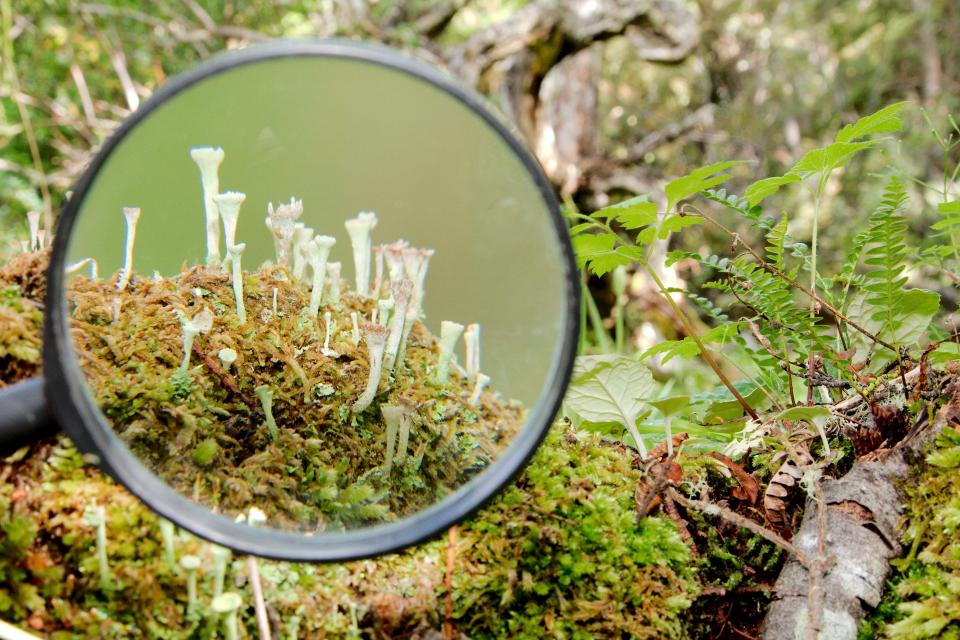
Figure 4a. Slow observations of the “miniature forests of Cape Horn” with the help of a magnifying glass or hand lens help us to perceive, understand, and value the microcosm formed by a rich subantarctic biodiversity of mosses, lichens, and other small organisms. These small but complex ecosystems have essential ethical, ecological, aesthetic, and economic values, which this exhibition aims to introduce. Photograph by Adam Wilson, Omora Park Photographic Archive, n.d.
Figure 4a. Slow observations of the “miniature forests of Cape Horn” with the help of a magnifying glass or hand lens help us to perceive, understand, and value the microcosm formed by a rich subantarctic biodiversity of mosses, lichens, and other small organisms. These small but complex ecosystems have essential ethical, ecological, aesthetic, and economic values, which this exhibition aims to introduce. Photograph by Adam Wilson, Omora Park Photographic Archive, n.d.
© Fundación Omora. Used by permission.
The copyright holder reserves, or holds for their own use, all the rights provided by copyright law, such as distribution, performance, and creation of derivative works.
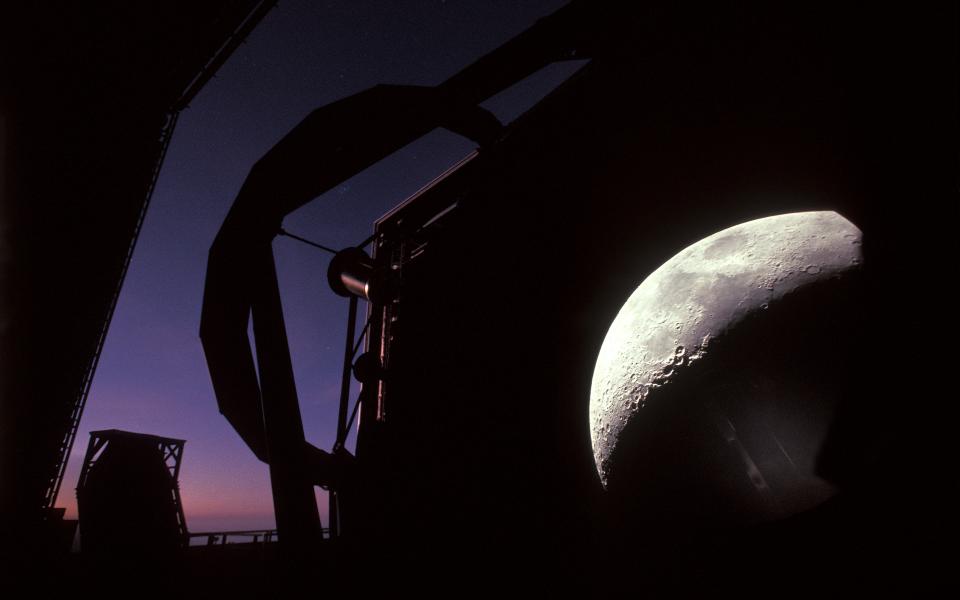
Figure 4b. Normally, the Moon is much too large and bright to be a target for the 8.2-meter Unit Telescopes (UTs) that make up ESO’s Very Large Telescope (VLT). The sheer power of the VLT is best reserved for much fainter and much more distant astronomical objects, such as exoplanets or exploding stars located at the edge of the visible universe. But back in 2002, it was possible for astronomers and engineers to have an unusual view of our natural satellite. In this case, the Moon’s image was projected onto a sandblasted glass plate. Photograph by Gerhard Hüdepohl, n.d.
Figure 4b. Normally, the Moon is much too large and bright to be a target for the 8.2-meter Unit Telescopes (UTs) that make up ESO’s Very Large Telescope (VLT). The sheer power of the VLT is best reserved for much fainter and much more distant astronomical objects, such as exoplanets or exploding stars located at the edge of the visible universe. But back in 2002, it was possible for astronomers and engineers to have an unusual view of our natural satellite. In this case, the Moon’s image was projected onto a sandblasted glass plate. Photograph by Gerhard Hüdepohl, n.d.
Courtesy of ESO/G.Hüdepohl (atacamaphoto.com).
Click here to view source.
 This work is licensed under a Creative Commons Attribution 4.0 International License.
This work is licensed under a Creative Commons Attribution 4.0 International License.
Biocultural laboratory is a metamorphosis of the concept of natural laboratory that focuses on the identification of the world’s places that have unique attributes for scientific research. By adapting the concept to biocultural laboratories, we aim to make explicit that biophysical and cultural dimensions are interwoven in the ways of observing and coinhabiting the biosphere, and more broadly the cosmos at multiple scales. This is particularly relevant because our worldviews and languages often remain invisible. In the twentieth century, philosopher Ludwig Wittgenstein called attention to the crucial role that language and concepts play in the ways we see the world. In this Virtual Exhibition, we highlight the relevance of the diversity of languages and disciplines to observe the world. Sciences, arts, and humanities play complementary roles in the appreciation of the macrocosm and microcosm (Figure 5).
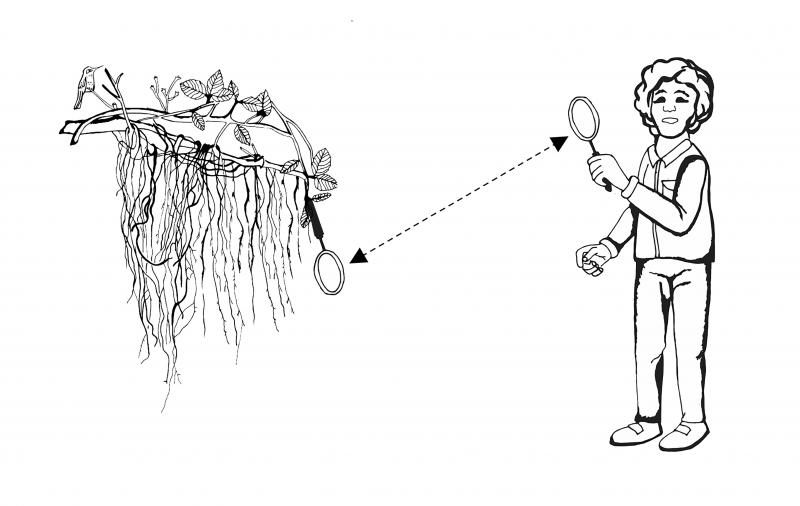
Figure 5. Scheme to illustrate that observing biodiversity entails bidirectional relationships between the biophysical attributes of the observed living beings (e.g., a lichen) and the cultural attributes of the human observer. The latter includes material culture (e.g., technological devices such as a magnifying glass) and immaterial culture (e.g., languages that include scientific and/or vernacular names of other living beings). For this reason, observing the microcosm of lichens, mosses, and other organisms is a biocultural experience. Illustration drawn by Mauricio Álvarez, adapted from Rozzi and Tauro (2023).
Figure 5. Scheme to illustrate that observing biodiversity entails bidirectional relationships between the biophysical attributes of the observed living beings (e.g., a lichen) and the cultural attributes of the human observer. The latter includes material culture (e.g., technological devices such as a magnifying glass) and immaterial culture (e.g., languages that include scientific and/or vernacular names of other living beings). For this reason, observing the microcosm of lichens, mosses, and other organisms is a biocultural experience. Illustration drawn by Mauricio Álvarez, adapted from Rozzi and Tauro (2023).
© Fundación Omora. Used by permission.
The copyright holder reserves, or holds for their own use, all the rights provided by copyright law, such as distribution, performance, and creation of derivative works.
At its extreme northern and southern regions, Chile aims to forge appropriate technological sensors as much as conceptual lenses to explore the cosmos. In this mission, we consider that philosophy, ethics, arts, and the humanities play a role which is as relevant as the one undertaken by engineering and the sciences. Telescopes and hand lenses contain mathematical and aesthetic languages, concepts, and values that shape our perceptions. To implement this biocultural vision, we take advantage of the major research platforms that Chile has implemented at both its northern and southern extremes. In the latter, among the remote fjords, mountains, glaciers, sea, and intact natural landscapes protected by the CHBR, a group of scientists, artists, philosophers, and other professionals, both Chilean and foreign, initiated a program of biocultural conservation in 1999, which led to the creation of the Omora Ethnobotanical Park in Puerto Williams, capital city of the Chilean Antarctic Province. The Omora Park research team has discovered that these archipelagoes are home to an exuberant diversity of mosses and lichens, wich are very sensitive to climate change (Figure 6).

Figure 6b. Ricardo Rozzi and Leopoldo Sancho observing Rhizocarpon geographicum, a lichen species that helps to date glacier-retreat processes at Pia Glacier in the Cape Horn Biosphere Reserve, Chile, n.d.
Figure 6b. Ricardo Rozzi and Leopoldo Sancho observing Rhizocarpon geographicum, a lichen species that helps to date glacier-retreat processes at Pia Glacier in the Cape Horn Biosphere Reserve, Chile, n.d.
© Fundación Omora. Used by permission.
 This work is licensed under a Creative Commons Attribution 4.0 International License.
This work is licensed under a Creative Commons Attribution 4.0 International License.

Figure 6c. Rhizocarpon geographicum, known as the map lichen, has been used for lichenometry. Its roughly circular diameter has been widely used to determine the relative age of glacial deposits (e.g., moraine systems), providing valuable information about glacial advances and retreats. Hence, this lichen is particularly valuable for assessing climate change. This is a biologically critical tool for climate-change studies. N.d.
Figure 6c. Rhizocarpon geographicum, known as the map lichen, has been used for lichenometry. Its roughly circular diameter has been widely used to determine the relative age of glacial deposits (e.g., moraine systems), providing valuable information about glacial advances and retreats. Hence, this lichen is particularly valuable for assessing climate change. This is a biologically critical tool for climate-change studies. N.d.
© Fundación Omora. Used by permission.
The copyright holder reserves, or holds for their own use, all the rights provided by copyright law, such as distribution, performance, and creation of derivative works.
The Omora Ethnobotanical Park was created to provide a biophysical and conceptual space for long-term scientific research, interdisciplinary environmental education, and biocultural conservation initiatives. As a biophysical space, it constitutes a biological reserve that protects the Róbalo River watershed, the source of drinking water for the town of Puerto Williams. Across the watershed, one encounters a diverse mosaic of habitats and biotic communities from the shoreline to the highest mountains of Navarino Island (Figure 7). This mosaic is distributed along a sharp altitudinal gradient of one thousand meters in which temperature decreases by 6º Celsius. This makes Omora Park an ideal site to empirically study the impact of climate change on the life cycles and distribution of subantarctic plants, insects, and other organisms (Figure 8).
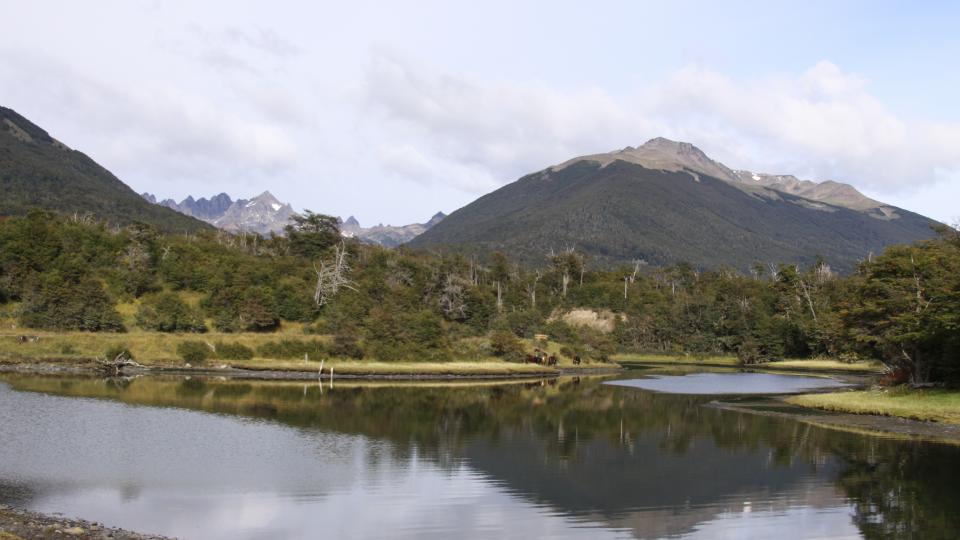
Figure 7. Róbalo River watershed protected by Omora Park. Photograph by Paola Vezzani, Omora Park Archive, n.d.
Figure 7. Róbalo River watershed protected by Omora Park. Photograph by Paola Vezzani, Omora Park Archive, n.d.
© Fundación Omora. Used by permission.
The copyright holder reserves, or holds for their own use, all the rights provided by copyright law, such as distribution, performance, and creation of derivative works.
As a conceptual space, the biocultural research and educational programs of the park integrate sciences, philosophy, and arts. In this way, the park functions as a natural laboratory as well as a biocultural laboratory, an outdoor classroom and training center, and a biocultural reserve, whose functions are incorporated into three broad domains of action: (1) transdisciplinary scientific research; (2) formal and informal education through school, university, and training courses; and (3) biocultural conservation linked with environmental decision-making and local sustainable development (Figure 9).
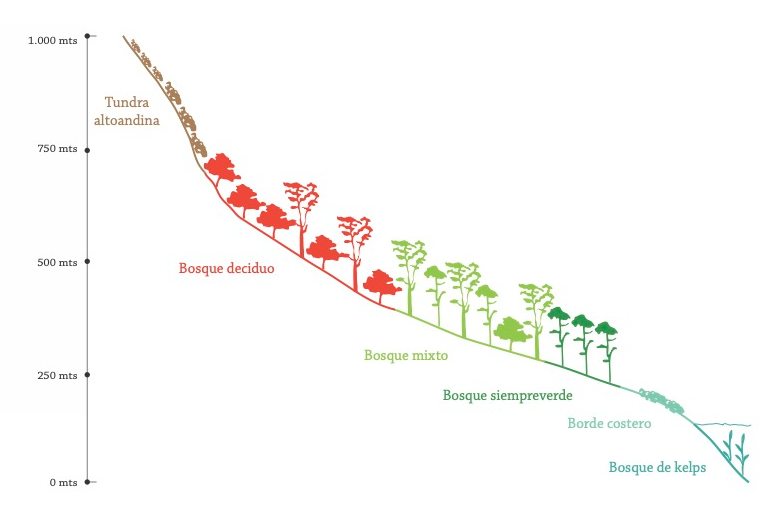
Figure 8. Detail of altitudinal gradient and sampling sites through the Róbalo River watershed protected by the Omora Park. To empirically investigate the impact of climate change on subantarctic insects and plants, long-term study sites along the altitudinal gradient are located at places with different temperatures and climatic conditions. Figure created by Silvia Lazzarino, n.d.
Figure 8. Detail of altitudinal gradient and sampling sites through the Róbalo River watershed protected by the Omora Park. To empirically investigate the impact of climate change on subantarctic insects and plants, long-term study sites along the altitudinal gradient are located at places with different temperatures and climatic conditions. Figure created by Silvia Lazzarino, n.d.
© Fundación Omora. Used by permission.
The copyright holder reserves, or holds for their own use, all the rights provided by copyright law, such as distribution, performance, and creation of derivative works.
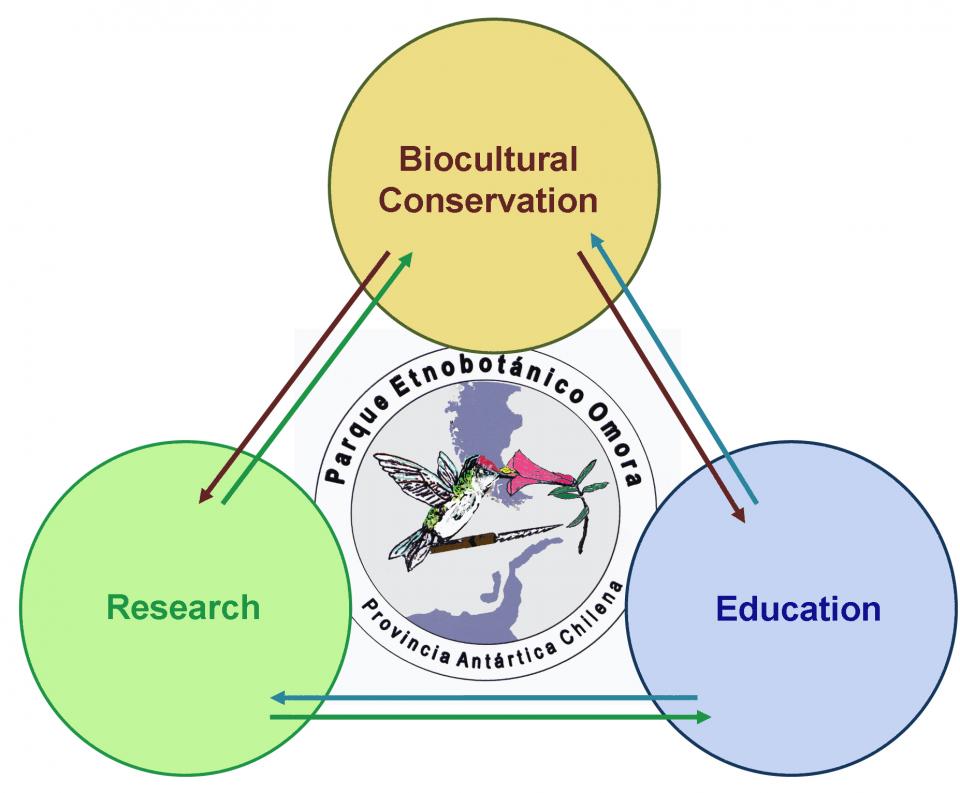
Figure 9. The Omora Ethnobotanical Park’s three domains of action are: (i) transdisciplinary research, (ii) formal and informal education, and (iii) biocultural conservation. Omora’s logo at the center emphasizes the integration between biological and cultural diversity by depicting the hummingbird Sephanoides sephaniodes, or Omora in Yahgan language, carrying a harpoon used by the Yahgan Indigenous people to fish in the subantarctic archipelago region, while visiting a flower of the Magellanic copihue (Philesia magellanica), the primary source of nectar for the hummingbird in the austral ecoregion. In the Yahgan narratives, Omora is seen as a bird, and at the same time a small person, a spirit who maintains social and ecological order. Figure from Rozzi et al. (2010).
Figure 9. The Omora Ethnobotanical Park’s three domains of action are: (i) transdisciplinary research, (ii) formal and informal education, and (iii) biocultural conservation. Omora’s logo at the center emphasizes the integration between biological and cultural diversity by depicting the hummingbird Sephanoides sephaniodes, or Omora in Yahgan language, carrying a harpoon used by the Yahgan Indigenous people to fish in the subantarctic archipelago region, while visiting a flower of the Magellanic copihue (Philesia magellanica), the primary source of nectar for the hummingbird in the austral ecoregion. In the Yahgan narratives, Omora is seen as a bird, and at the same time a small person, a spirit who maintains social and ecological order. Figure from Rozzi et al. (2010).
© Fundación Omora. Used by permission.
The copyright holder reserves, or holds for their own use, all the rights provided by copyright law, such as distribution, performance, and creation of derivative works.

Figura 10. El Centro Internacional Cabo de Hornos (CHIC) está alojado en la Universidad de Magallanes (UMAG), Chile, e inspirado en la obra América Invertida de Joaquín Torres García, para forjar una imagen institucional que exprese una perspectiva biocultural emergente desde el sur geográfico. Imagen adaptada compuesta en 2016 y publicada por primera vez en Rozzi et al. (2020).
Figura 10. El Centro Internacional Cabo de Hornos (CHIC) está alojado en la Universidad de Magallanes (UMAG), Chile, e inspirado en la obra América Invertida de Joaquín Torres García, para forjar una imagen institucional que exprese una perspectiva biocultural emergente desde el sur geográfico. Imagen adaptada compuesta en 2016 y publicada por primera vez en Rozzi et al. (2020).
© Fundación Omora. Utilizada con permiso.
El titular de los derechos de autor se reserva, o conserva para su propio uso, todos los derechos previstos por la legislación sobre derechos de autor, como la distribución, la ejecución y la creación de obras derivadas.
Perceptions and the capacity to observe the micro- and the macrocosm shape our realities, and have profound ethical implications. For example, if we observe only large vascular plants (e.g., trees, shrubs, vines), the implication is clear: we will conserve only vascular plants. We will not be able to see the non-vascular plants (e.g., mosses, liverworts, lichens) that dominate the high latitudes of our planet, and we will thus fail in our conservation efforts at high latitudes. But this violates the basic tenet of conservation biology: to conserve all species diversity. Therefore, we must no longer see conservation of flora as conservation only of vascular plants. The logic of this argument is inescapable. But logic alone rarely motivates action. Scientific facts will not, on their own, guarantee that the diversity of beings will be conserved. To stimulate the appreciation of the micro- and macrocosms, in this Virtual Exhibition we propose a “change of lenses” to treasure the beauty of coinhabiting amid an outstanding diversity of gigantic and tiny beings (Figure 10).
This Virtual Exhibition also invites the viewers and readers to observe and appreciate the macrocosm through the windows opened by the telescopes in the Atacama Desert of northern Chile, and the microcosm through the physical and conceptual hand lenses located at the CHBR in southern Chile. We hope to encourage readers to travel virtually (and eventually physically) to these remote, pristine, beautiful regions of our planet, and through their visits come away transformed, seeing and valuing things differently. This transformation aims to orient sensitive and responsible coinhabitation. We gain awareness of coinhabitation through our abilities to change our lenses, realizing that we are members of communities of coinhabitants, embedded amongst a myriad of beings that have existed before us, and will continue existing after us.


